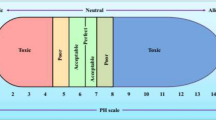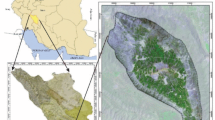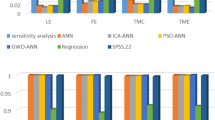Abstract
Field capacity (FC) and permanent wilting point (PWP) are two important properties of the soil when the soil moisture is concerned. Since the determination of these parameters is expensive and time-consuming, this study aims to develop and evaluate a new hybrid of artificial neural network model coupled with a whale optimization algorithm (ANN-WOA) as a meta-heuristic optimization tool in defining the FC and the PWP at the basin scale. The simulated results were also compared with other core optimization models of ANN and multilinear regression (MLR). For this aim, a set of 217 soil samples were taken from different regions located across the West and East Azerbaijan provinces in Iran, partially covering four important basins of Lake Urmia, Caspian Sea, Persian Gulf-Oman Sea, and Central-Basin of Iran. Taken samples included portion of clay, sand, and silt together with organic matter, which were used as independent variables to define the FC and the PWP. A 80–20 portion of the randomly selected independent and dependent variable sets were used in calibration and validation of the predefined models. The most accurate predictions for the FC and PWP at the selected stations were obtained by the hybrid ANN-WOA models, and evaluation criteria at the validation phases were obtained as 2.87%, 0.92, and 2.11% respectively for RMSE, R2, and RRMSE for the FC, and 1.78%, 0.92, and 10.02% respectively for RMSE, R2, and RRMSE for the PWP. It is concluded that the organic matter is the most important variable in prediction of FC and PWP, while the proposed ANN-WOA model is an efficient approach in defining the FC and the PWP at the basin scale.







Similar content being viewed by others
References
Aghelpour P, Mohammadi B, Biazar SM (2019) Long-term monthly average temperature forecasting in some climate types of Iran, using the models SARIMA, SVR, and SVR-FA. Theoretical Appl Climatol:1–10. https://doi.org/10.1007/s00704-019-02905-w
Aljarah I, Faris H, Mirjalili S (2018) Optimizing connection weights in neural networks using the whale optimization algorithm. Soft Comput 22(1):1–15. https://doi.org/10.1007/s00500-016-2442-1
Bishop TFA, McBratney AB (2001) A comparison of prediction methods for the creation of field-extent soil property maps. Geoderma 103:149–160. https://doi.org/10.1016/S0016-7061(01)00074-X
Chen W, Panahi M, Pourghasemi HR (2017) Performance evaluation of GIS-based new ensemble data mining techniques of adaptive neuro-fuzzy inference system (ANFIS) with genetic algorithm (GA), differential evolution (DE), and particle swarm optimization (PSO) for landslide spatial modelling. Catena 157:310–324
Deo RC, Ahin M (2016) An extreme learning machine model for the simulation of monthly mean streamflow water level in eastern Queensland. Environ Monit Assess 188(2):90. https://doi.org/10.1007/s10661-016-5094-9
Ghorbani MA, Shamshirband S, Haghi DZ, Azani A, Bonakdari H, Ebtehaj I (2017) Application of firefly algorithm-based support vector machines for prediction of field capacity and permanent wilting point. Soil Tillage Res 172:32–38
Jafarnejadi AR, Abbssayyad GH, Arshad RR, Davami A (2012) Pedotransfer functions development for field capacity and permanent wilting points using artificial neural networks and regression models. Int J Agric: Res Rev 2:1079–1084
Jahani B, Mohammadi B (2018) A comparison between the application of empirical and ANN methods for estimation of daily global solar radiation in Iran. Theoretical Appl Climatol:1–13. https://doi.org/10.1007/s00704-018-2666-3
Kaveh A, Ghazaan MI (2017) Enhanced whale optimization algorithm for sizing optimization of skeletal structures. Mech Based Design of Struct Machines 45(3):345–362. https://doi.org/10.1080/15397734.2016.1213639
Keshavarzi A, Sarmadian F, Sadeghnejad M, Pezeshki P (2010) Developing pedotransfer functions for estimating some soil properties using artificial neural network and multivariate regression approaches. Proenviron Promediu 3(6):322–330
Keshavarzi A, Sarmadian F, Zolfaghari AA, Pezeshki P (2012) Estimating water content at field capacity and permanent wilting point using non-parametric K-NN algorithm. Int J Agric Res 7:166–168
Khosla R, Fleming K, Delgado JA, Shaver T, Westfall DG (2002) Use of site-specific management zones to improve nitrogen management for precision agriculture. J Soil Water Conserv 57:513–518
Kisi O, Shiri J, Karimi S, Shamshirband S, Motamedi S, Petkovic D, Hashim R (2015) A survey of water level fluctuation predicting in Urmia Lake using support vector machine with firefly algorithm. Appl Math Comput 270:731–743
Liu D, Wang Z, Zhang B, Song K, Li X, Li J, Li F, Duan H (2006) Spatial distribution of soil organic carbon analysis of related factors in cropland of the black soil region, Northeast China. Agric Ecosyst Environ 113:73–81. https://doi.org/10.1016/j.agee.2005.09.006
Merdun H, Çınar Ö, Meral R, Apan M (2006) Comparison of artificial neural network and regression pedotransfer functions for prediction of soil water retention and saturated hydraulic conductivity. Soil Tillage Res 90(1–2):108–116. https://doi.org/10.1016/j.still.2005.08.011
Minasny B, McBratney A (2002) The neuro-m method for fitting neural network parametric pedotransfer functions. Soil Sci Soc Am J 66(2):352–361
Mirjalili S, Lewis A (2016) The whale optimization algorithm. Adv Eng Softw 95:51–67. https://doi.org/10.1016/j.advengsoft.2016.01.008
Moazenzadeh R, Mohammadi B (2019) Assessment of bio-inspired metaheuristic optimisation algorithms for estimating soil temperature. Geoderma 353:152–171. https://doi.org/10.1016/j.geoderma.2019.06.028
Moazenzadeh R, Mohammadi B, Shamshirband S, Chau KW (2018) Coupling a firefly algorithm with support vector regression to predict evaporation in northern Iran. Eng Appl Comput Fluid Mech 12(1):584–597. https://doi.org/10.1080/19942060.2018.1482476
Mohammadi B (2019a) Letter to the editor “estimation of sodium adsorption ratio indicator using data mining methods: a case study in Urmia Lake basin, Iran” by Mohammad Taghi Sattari, Arya Farkhondeh, and John Patrick Abraham. Environ Sci Pollut Res:1–2. https://doi.org/10.1007/s11356-019-04368-y
Mohammadi B (2019b) “Prediction of effective climate change indicators using statistical downscaling approach and impact assessment on pearl millet (Pennisetum glaucum L.) yield through genetic algorithm in Punjab, Pakistan” by Asmat Ullah, Nasrin Salehnia, Sohrab Kolsoumi, Ashfaq Ahmad, Tasneem Khaliq. Ecol Indic 101:973974. https://doi.org/10.1016/j.ecolind.2019.02.013
Mohammadi B (2019c) Predicting total phosphorus levels as indicators for shallow lake management. Ecol Indic 107:105664
Mohammadi B (2019d) Letter to the Editor “Design of an integrated climatic assessment indicator (ICAI) for wheat production: A case study in Jiangsu Province, China” by Xiangying Xu, Ping Gao, Xinkai Zhu, Wenshan Guo, Jinfeng Ding, Chunyan Li, Min Zhu, Xuanwei Wu. Ecol Indic 103:493
Mohammadi B (2020) Letter to the editor “Generating electrical demand time series applying SRA technique to complement NAR and sARIMA models” by Jorge L. Tena García, Erasmo Cadenas Calderón, Eduardo Rangel Heras, Christian Morales Ontiveros. Energy Efficiency 13 (1):157–158
Mohanty M, Sinha NK, Painuli DK, Bandyopadhyay KK, Hati KM, Reddy KS, Chaudhary RS (2015) Modelling soil water contents at field capacity and permanent wilting point using artificial neural network for Indian soils. Nat Acad Sci Lett 38(5):373–377
Mzuku M, Khosla R, Reich R, Inman D, Smith F, MacDonald L (2005) Spatial variability of measured soil properties across site-specific management zones. Soil Sci Soc Am J 69:1572–1579
Nelson DW, Sommers L (1982) Total carbon, organic carbon and organic matter. In: Page, A.L., Keeney, D.R. (Eds.), Methods of soil analysis, Part II. Agronomy, 532–581
Pachepsky YA, Rawls WJ (2003) Soil structure and pedotransfer functions. Eur J Soil Sci 54(3):443–452
Rab MA, Chandra S, Fisher PD, Robinson NJ, Kitching M, Aumann CD, Imhof M (2011) Modelling and prediction of soil water contents at field capacity and permanent wilting point of dryland cropping soils. Soil Res 49(5):389–407. https://doi.org/10.1071/SR10160
Romano N, Hopmans JW, Dane JH (2002) Suction table. Methods Soil Anal Part 4:692–698
Sarmadian F, Taghizadeh MR (2008) Modeling of some soil properties using artificial neural network and multivariate regression in Gorgan Province, north of Iran. Global J Environ Res 2(1):30–35
Sarmadian F, Taghizadeh MR, Akbarzadeh A (2009) Optimization of pedotransfer functions using an artificial neural network. Aust J Basic Appl Sci 3(1):323–329
Slatyer RO (1967) Plant-water relationships. Academic Press, New York, pp 73–77
SSSA (1984) Glossary of soil science terms. Soil Science Society of America, Madison
Vaheddoost B, Aksoy H (2017) Structural characteristics of annual precipitation in Lake Urmia Basin. Theoretical Appl Climatol 128(3):919–932
Veihmeyer FJ, Hendrickson AH (1949) Methods of measuring field capacity and permanent wilting percentage of soils. Soil Sci 68(1):75–94
Wosten JHM, Pachepsky YA, Rawls WJ (2001) Pedotransfer functions: bridging the gap between available basic soil data and missing soil hydraulic characteristics. J Hydrol 251(3–4):123–150. https://doi.org/10.1016/S0022-1694(01)00464-4
Acknowledgments
The authors are thankful for the reviewers and the editor for their insightful comments which are used in enhancement of the article as well as the Agricultural and Natural Resources Research Center of Iran for providing the data used in this study.
Author information
Authors and Affiliations
Corresponding author
Additional information
Responsible editor: Marcus Schulz
Publisher’s note
Springer Nature remains neutral with regard to jurisdictional claims in published maps and institutional affiliations.
Rights and permissions
About this article
Cite this article
Vaheddoost, B., Guan, Y. & Mohammadi, B. Application of hybrid ANN-whale optimization model in evaluation of the field capacity and the permanent wilting point of the soils. Environ Sci Pollut Res 27, 13131–13141 (2020). https://doi.org/10.1007/s11356-020-07868-4
Received:
Accepted:
Published:
Issue Date:
DOI: https://doi.org/10.1007/s11356-020-07868-4




